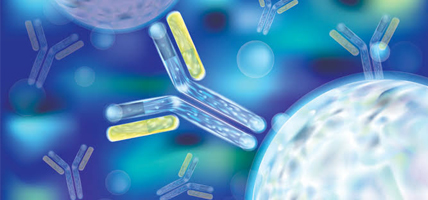


Antibody (Magic bullet) stands for immunoglobulins (Ig) or glycoprotein molecules secreted by the plasma cells. The term was given by Paul Ehrlich (1854-19915) in 1891. Antibody act as soldiers of the immune system to identify, countercheck and destroy pathogens (foreign bodies) mainly the viruses and the bacteria. They are specific to their target and enough sensitive to detect endogenous action.
The apprehension of the utility of the explicit antibody-antigen interaction at the end of the 19th century has led to the emanation of divergence of immunotechnologies. Today most of it is still in use as the test of precipitin for analyzing components of blood to highly distinct chromatin immunoprecipitation tactics to auto image flow cytometry antibody-based tools and immunostaining continues playing a crucial act in biomedical research and biotechnology.
The high sensitivity and specificity of antibodies (magic bullets) are veracious advantages in research applications. Breakthroughs in Biotechnology have enabled the large scale production of antibodies. The conventional procedure like flow cytometry, ELISA, western blot, immunohistochemistry and many others depends on antibodies. This section furnishes an overview of the applications of antibodies in Biotechnology research are as follows:-
1) Immunoprecipitation (IP):- It is termed as precipitating technique or pull-down assay in which antibodies are treated to level and precipitate target antigen from an aqueous sample, cell lysate and other biological fluids on an immobilized solid support. A widely used mechanism for protein isolation, measuring molecular weight, to express a level of protein, nucleic acid interaction and determination of post-translational modification. This method expedites by discrepant kind of beads (sepharose, magnetic, agarose) binding to Fc region of the antibody and the separation of antigen-antibody complexes by centrifugation and auxiliary mechanical methods.
2) Western Blotting (WB):- Also known as protein blotting. It is an analytical method involving protein electrophoretic separation of protein on a gel, then immobilized or transferred on an absorbent membrane (nitrocellulose or PVDF) for immunodetection using high specific antibodies through an electric charge. When the protein blotted can be detected with specifically labelled antibodies.
3) Immunosorbent Assay (IA):- Enzyme-linked immunosorbent assay (ELISA) technique is highly popular for quantitative and qualitative analysis of concentration and presence of particular antigen and analyte (macromolecule- lipids, proteins, nucleic acids, carbohydrates, toxins, drugs and small molecules). These assays employ highly specific antibodies for different target antigens. Monoclonal antibodies are used in direct ELISA whereas, primary and secondary antibodies are used in indirect ELISA to detect the specific antigen in a solution. These assays consist of polystyrene plates having the ability to bind proteins which include antibodies. Extensively these assays blend colourimetric endpoint detection through absorbance wavelength estimated from a known standard curve of antibody or antigen dilutions. The exposure antibody is generally designated with an enzyme- alkaline phosphatase or horseradish peroxidase (HRP) or electrochemiluminescent label or fluorescent tags.
4) Immunohistochemistry (IHC) / Immunocytochemistry (ICC):- These process or technique are used in situ determination marking the presence and location of proteins using specific antibodies. Primary antibodies bind the target antigen and secondary antibodies for detection of antigen of primary antibodies complexes.
5) Chromatin immunoprecipitation (ChIP):- This is also a type of immunoprecipitation (IP) technique employ for investigating the interaction between DNA and protein in the cells. It widely used to analyze transcription factors binding, DNA repair and replication of DNA.
6) Flow Cytometry (FC):- This technology is laser-based for intracellular analysis used to sort cells, count cells and detect protein (biomarker) suspended on surface of fluid stream with high specific fluorochrome tagging antibodies for easy detection and also labelled with numerous antibodies capable of 3 or more fluorochrome and thus helping in detection of proteins in the nucleus, endosomes and cytosol.
7) Peptide Competition Assay (PCA):- It is a procedure recommended for affirming the specific reactivity band of polyclonal antibody anti-peptide, mainly domain-specific antibody (phospho). To see more than one band on immunoblots of lysate of cell probing primary antibody is not uncommon. This PCA helps in determining which pattern of staining is specific for the antibody.
8) Neutralization Assay (NA):- An immunoassay in which the antibody blocks the biological process. This assay includes antibodies blocking the ability of certain pathogens (foreign molecules like virus and bacteria) entering the cells.
9) SDS-PAGE:- Referred to as Sodium dodecyl sulphate - polyacrylamide gel electrophoresis, and extensively used technique for separation of a complex mixture of proteins through electrophoretic mobility (is independent of conformation or charge). This technique is performed by molecular weight standard and pre-stained with a buffer for visualization to obtain optimum results.
10) Immunofluorescence (IF) Microscopy:- This technique is based on light microscopy which uses a fluorescent microscope or stimulated emission depletion microscopy or confocal microscopy system of imaging for detection of antigen in tissue or cell primary or secondary antibody conjugated fluorescent probe.
11) Gel Shift Assay (GSA):- Popularly known as electrophoretic mobility shift assay (EMSA) or mobility shift electrophoresis (MSE). This technique of electrophoresis is based on affinity used for protein-RNA or protein DNA interaction combined with a specific antibody to detect protein component, mobility shift referred to as gel supershift assay (SSA).
There is still the appropriate large extent of practical and theoretical development endeavour required in this area. For applying any of these methods it is clear that it will require substantial laboratory-based fundamental research and consequently mortgage to identify biological and structural properties of each quantum as well as to develop and standardize the methods for technical aspects which will revolutionize the biotechnology field.
